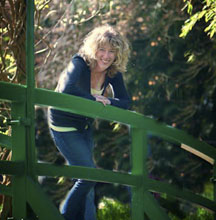BARCELONA!
The Journey
As we packed and prepared to leave home, I wondered why we were doing this.
The short answer? To redeem our Barcelona apartment dates from Covid times. But I couldn’t quite shake those feelings of terror from our last two trips to Paris. We’d fled during the initial pandemic outbreak in March of 2020 and again after suffering our own Covid illness there in March of 2022.
To put it mildly, Europe triggered me. Or more accurately, I reminded myself, Paris triggered me. Though still Europe, Barcelona didn’t scare me quite so much. It made little sense, but I felt relieved to be going to this Catalan region of Spain instead of France.
Our flight had a medical emergency, an otherwise healthy-looking young man suffering a diabetic episode and completely spacing out. Flight attendants called for medical folks who provided oxygen and IV, at one point placing him flat outside the bathroom. We worried not just about him but that the plane might get diverted. Fortunately the guy eventually perked up and we all made it safely to Barcelona.
We seem to be encountering more emergency flights overseas in recent years—a medical crisis flying to Hawaii, a threatening bi-polar lady en route to Amsterdam, and now this diabetic dude. I wonder if it has to do with airlines increasingly packing planes through cancellation and consolidation. More people on flights statistically means more opportunities for complications.
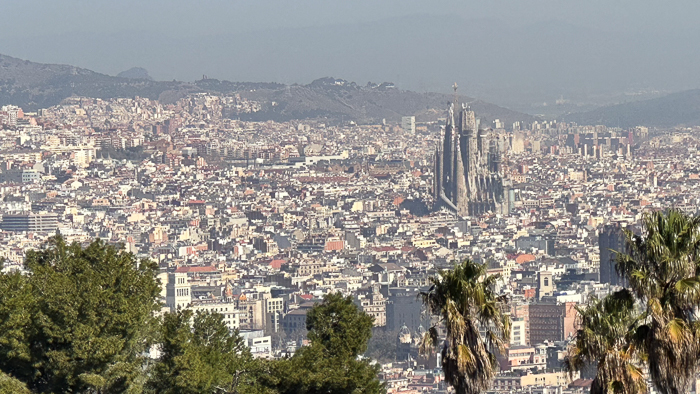
Arrival
Jim and I love our apartment and enjoyed finally meeting delightful owner Isabel in person after years of communication with her online. We hugged like old friends. I thanked again her for allowing us to redeem this supposedly non-cancellable rental we’d booked for March 2020. Isabel said that every other apartment owner she knows in Barcelona offered the same pandemic courtesy.
This supposedly first floor apartment feels more like the fourth with mezzanine levels between us and the entry level. It boasts beautiful original tiles floors painted in mosaic designs, all surviving nearly a century. Towering ceilings and lanky french doors lead to petite balconies, urban features that surely provided life-lines during pandemic lockdowns.
The apartment would be considered generous-sized in most of Barcelona, no doubt. I shudder thinking how awful it must have been for residents to be trapped in tiny units during Covid, not even permitted out for a walk in the park or plaça .

We briefly re-visited some of my old haunts. I took a photo of the hotel on Las Ramblas where my high school Spanish class stayed in 1977 and texted it to two friends, Sharon and Beth, who’d joined me on that experience. And I showed Jim where Annie spun in the Plaça de Catalunya and later danced outside the cathedral on our 2007 journey together.
People in Barcelona radiate the same joy I’d witnessed on that 2007 trip with vacationers in town escaping Madrid’s summertime heat. But it's mid-March now and the city still maintains that happy, holiday feel. As we strolled down the street to explore the city, my European pandemic triggers faded away. I turned to Jim and said, “This is why we came here.”
The Ecco Shoe
As usual, jet-lag woke us in crazy hours our first overseas morning. I suggested we leave a half hour early before our ticket check-in time for the Sagrada Familia Basilica. Visiting this church was the primary reason I’d included Barcelona in our original 2020 itinerary. I wanted to witness the construction progress of it in person.
My Spanish class never got to see the Sagrada Familia back in 1977 because of a bus strike, though it was only a shell of itself then with just the Nativity facade completed. Gaudi had correctly predicted that the facade would inspire citizens to continue building. Work stopped during the Spanish Civil War while some revolutionaries vowed to destroy it due to the Catholic alliance with dictator Franco. Ultimately they spared the project because of its artistic value.
Our walk from our apartment to the Sagrada Familia took about 25 minutes. As we neared, I felt a situation with my left shoe, like I’d accidentally stepped into something disgusting. I checked the soles of my old black Ecco walking shoes and noticed that a big piece of the rubber on my heel had disappeared. We pivoted for the apartment to change footwear, grateful we’d left early, but now had to hustle.
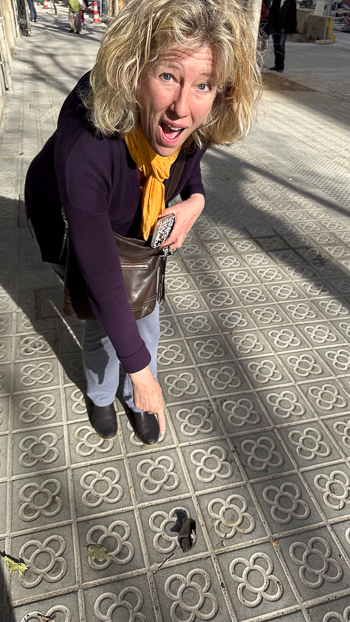

A couple of minutes later, more of my heel fell off, this time in an even larger chunk. Shortly after that, a portion of my right shoe disintegrated and parts went missing.
At the apartment, I grabbed my other pair of Ecco shoes but decided to examine the soles first. Sure enough, the rubber had already begun fracturing.
I realized something about these Ecco soles I’d used solely for tromping all about Europe since 2008: They carry a specific time stamp on their rubberized life.
Fortunately I still had my non-Ecco ankle boots. Though they lacked cushion, they hadn’t fallen apart, surely a low bar. I almost hadn’t packed them as I generally find two pairs of shoes sufficient, but something prompted me to include them.
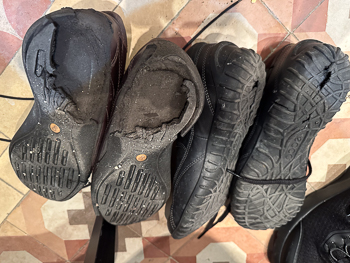
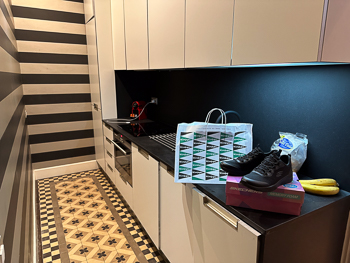
We encountered my crumbs of rubber sole as we retraced our steps to the Sagrada Familia, Hansel and Gretel-style. They looked like turds from miniature dogs Paris Hilton might carry in her designer bags. We found two Ecco deposits along the sidewalk but the third had already been cleared away, the locals fastidious about such droppings; we’ve witnessed them scrubbing sidewalks with mops and soapy water.
My boots got me where I needed to go, but didn’t mesh well with the stoney and uneven ground. Jim suggested we stop at Spain’s landmark El Corte Ingles department store to purchase more appropriate shoes for the rest of our trip.
El Corte Ingles reminded us both of downtown Portland’s old Meier and Frank store from our youth with its multiple levels stacked atop each other—minus the fantastical Christmas village on the ninth floor.
We found some Sketcher shoes and somewhat helpful sales gals. The locals here speak both Spanish and Catalan, which is a conglomeration of Spanish, French, Italian and maybe Portuguese. They seemed relieved that I spoke sufficient Spanish that they didn’t have to switch to English.
I have a theory, by the way, about the language. The locals already have to learn Catalan and Spanish, so expecting mastery of a third language like English is a lot to ask.
Anyway, after my shoe mis-hap, Jim went from hoping we could locate a shoe store to noticing them everywhere. I don’t know if it’s a Spain thing or just a Barcelona thing, but they’re ubiquitous, and he’s documenting them all with his camera.
The Catalans
Back in the 1970s, I read that Barcelona seemed more European than other parts of Spain. When I’d visited Barcelona my first two times, I’d not yet seen Paris. Now I notice lots of similarities between the two cities in terms of architecture and the general vibe on the street. The Catalans value beauty and their abundant public art and plane trees evoke France. The city also brings to mind Lisbon with its mosaic tiles and seafront location.
We went to Pizza Local for lunch, supposedly the best pizza in Barcelona, and I believe it. Our waiter asked us what state we came from in the US. When we answered Oregon, he grinned and said, “The Goonies!”
I took a photo of the large, funky mural in front of Pizza Local’s bathrooms for possible inclusion into Jim’s upcoming “Bringing Art Home” continuing education lecture at Willamette University, a talk about incorporating travel art and ideas into your daily life. Our waiter spotted me and offered to snap a shot of me in front of that red restroom wall. Why not, I thought? Jim looked puzzled from the other end of the restaurant.
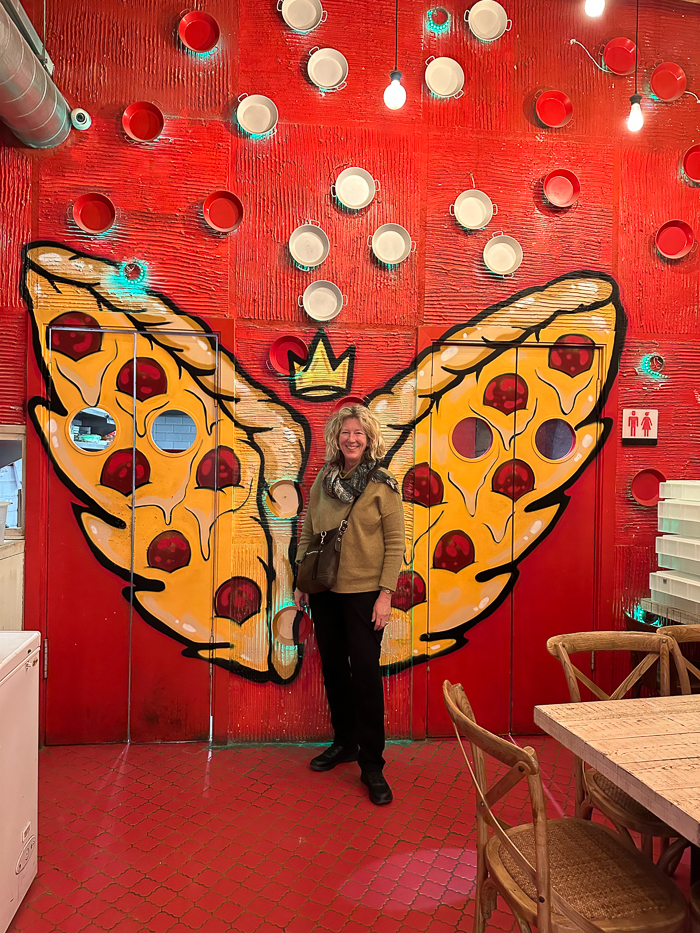
I’ve been thinking about how kind the locals are to us, even when we bumble and screw up. So far we’ve not encountered any cranky, strict Spanish matrons prone to scolding like they did in Madrid for not intuitively understanding their rules. Unlike Madrid, you can even sit or walk on grass in Barcelona without getting chewed out.
I can think of three possible reasons for this:
1. While a large city, Barcelona offers a major vacation destination on the Mediterranean. Warm breezes sway palm trees. Cruise ships dock alongside multi-million dollar yachts. It’s a fun and colorful place. The heart of the city, Las Ramblas, serves as an attraction simply for its promenade of humanity.
2. Catalans love their unique culture and seek to differentiate themselves through language, music, art, food and dance. They celebrate it, as well as life in general, every chance they get.
3. Barcelona has their share of anarchists who, by their very nature, steer clear of rules.
You’ll find no hint of flamenco dancers or bullfighters beyond tiny trinkets at the tackiest of souvenir shops. That doesn’t happen here. One of the premier animal rights activists once owned our apartment and played a major role ending the practice of bullfighting in Barcelona. Her piano still sits in the foyer of our place. I’m tempted to practice.
Catalan Food
Even the food differs here from the rest of Spain. We’ve seen few menu boards outside restaurants advertising the traditional three course meal of the day here. You’re more likely to find continental cuisine, French patisseries and Italian trattorias.
Decades ago, the city converted its former bull ring, Las Arenas, into a mall, where we ate our most traditional Spanish meal of the trip. I ordered vegetarian paella and Jim had roast chicken. (All good, except Jim had to dissect the meat off the bones, his particular bane of dining.) We both ate green salads with bottled oil and vinegar on the tables as the only dressing option, very Spanish typical.
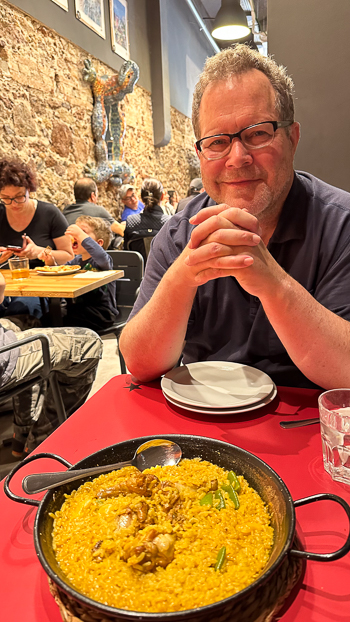
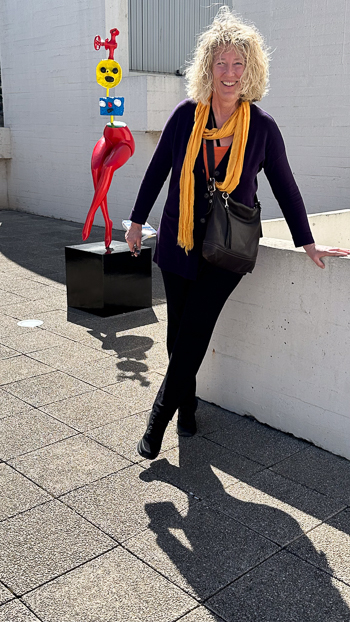
We lunched alone at 1 PM, early for most Spaniards, but the restaurant brimmed with older folks an hour later. Around our bull ring bend, the pizzeria overflowed with younger people. I wondered if the newer generations have less interest in traditional foods like paella anymore, especially here in Catalunya.
When Annie and I traveled here in 2007, she’d had her fill of conventional Spanish restaurants so we hunted Italian places even before it turned into the thing to do. She’d not have any concerns these days since gastronomically Barcelona feels less Spanish and more French or Italian.
Somewhere Between Spain and France
Yes, Barcelona resembles Paris more than Madrid in many ways but with a lack of pretense and a lot more playfulness. Geographically it sits only 93 miles from the French border. I accidentally called a clerk “Madame” and Jim answered a question with “oui.” I vowed to stop that before asking a waiter a simple question in French, to which he replied in kind. The city jumbles my linguistic mind.
I love France, but once heard it described with the following: France is like the older matron who still demands the best seat at the table even though she’s past her prime and no longer holds any real authority. She simply considers the attention and respect her birthright.
If I were to further this analogy, I’d say Barcelona has emerged as the youthful descendant at the table, something so lovely that everyone can’t keep their eyes off of her. Yet she remains humble and approachable. She’s either unaware of her beauty or has simply refused to let it go to her head.
We ate lunch at the Joan Miró Museum today. Almost everyone spoke Spanish to me there; I gather they don’t get a ton of Americans at a Catalan art museum, and they seemed happy not having to use English with us, particularly the older staffers.
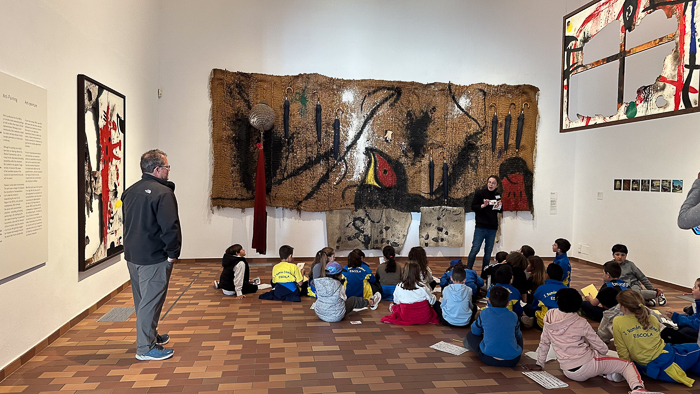
The waiter asked if we had a reservation. I said no, but it didn’t appear a problem as first arrivals for their 1 PM opening.
A French couple our age did have a reservation and shoved past us for the window table. When we got seated next to them, Madame gave me the stink eye. She wore chic couture and pursed lips. I’m unsure if her distaste for us was because:
- We were Americans.
- We failed to make a reservation.
- I carried a Rick Steves guidebook.
- Jim wore a blue t-shirt.
The couple fussed over which wine to order, struggling with the staff in halting English as the common language.
Our waiter, a light-hearted chap, took our order of bottled water. “Still” versus “gassy” water remains an important question in Europe. Furthermore, did we wanted our water “fria” or “natural?” This query puzzled me, especially in Spanish, until we determined it involved chilled versus room temperature.
The French couple maintained their soured expressions and ignored us completely despite our proximity in the little alcove together with nobody else nearby the entire time.
Jim had ice cream on his brain so he tasked me with asking the flavors. I heard several choices, but understood only strawberry, coffee, and chocolate. No problem, they had us at chocolate.
The French couple eavesdropped then ordered chocolate ice cream, too.
After lunch, Jim needed to use the restroom, experiencing some intestinal challenges on the trip. French man followed Jim in soon after. Jim emerged and said, “I feel sorry for that guy. He may not make it out alive after what I did in there.”
I confess I didn’t feel so bad.
Greater Spain Resentment
From Joan Miró, we hiked downhill to the Palace of Catalan Art Museum.
In the 1920s, private art collectors started purchasing and removing 10-12th century frescos from village churches in northern Spain. The Catalan Art Gallery intervened and bought them for their museum instead. To detach the original frescos from the church walls, they laid sticky cloths on top and peeled back.
Undoubtedly they damaged many frescos this way, but at least they still exist for public viewing. The museum presents the frescos as accurately as possible, recreating big and little niches mimicking altar alcoves for their display.
Our scripture knowledge proved useful in helping us analyze meanings of some of the frescos. We recognized the Ezekiel imagery of the spinning wheels and angel wings with multiple eyes, something our Bible study groups recently studied.
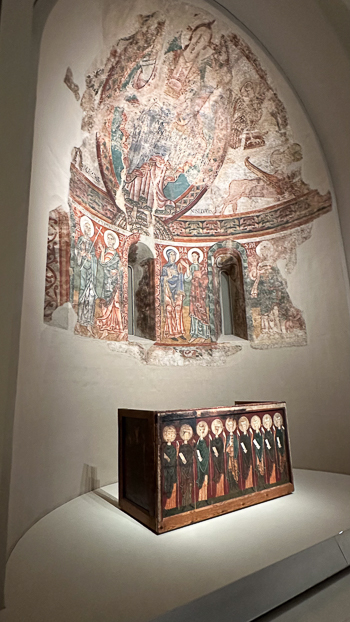
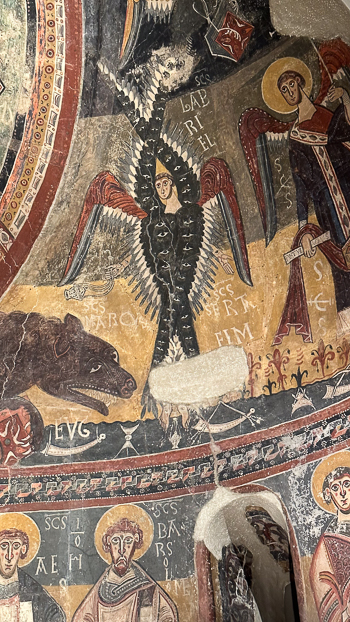
We tried to recall the symbolism that each apostle historically holds as an identifier, such as Peter grasping keys. In medieval times, a significant portion of the population was illiterate and learned their Bible through art in the churches. Clues like the keys assisted the story-telling.
A Spanish man overheard us and helped sort out more of the imagery. He grew up in Madrid but spent years in London as well as Philadelphia. He worked as a chemist but loved art. We talked about Barcelona and he said he adored the city but was disappointed how the Catalans “use their language as a political tool.” He suggested they promoted their distinct language as part of their ongoing effort for autonomy from the rest of Spain.
Grocery Shopping
We approached a recommended grocery store around the corner from our apartment. Jim suggested he wait outside while I shop in case they didn’t appreciate us bringing in my shoe-filled El Corte Ingles bag, but I said I needed him. And I surely did.
We couldn’t locate bottled water or bottled much of any beverage except wine, so I asked in Spanish where that might be. “Abajo,” the clerk answered. We descended to the basement by elevator to locate our water and to my delight, diet Fanta Limon. This reminded me greatly of sipping Fanta Limon at age 16 in Barcelona with my Spanish class. We’d order glasses on the sidewalk tables of Las Ramblas for about 50 cents.
Jim needed ice cream. They had such an odd and slight selection that I wondered if we’d missed another subterranean floor of just frozen dairy, but we found enough to satisfy him.
Then the real trouble began. They had no workers at the regular check out so we had to scan our groceries ourselves.
Self-scanning at Fred Meyer in Salem is challenge enough, but this took us to a whole new level. To begin, all the prompts came in Catalan. Not even Spanish, but Catalan. Fortunately the languages read close enough that I could understand it. Sort of.
But we blundered with our scanning of Fanta Limon and the machine screamed for a helper who took some time to materialize. We also failed to scan our purchased plastic bags as we went. Then I worried that if I tried to scan our two already-filled sacks, the machine would recharge us for our goods packed inside. So I grabbed an extra bag and scanned it three times. I figured we could simply redistribute the groceries from two bags to three and pay for that extra six cent sack. But my solution rattled both the machine and our helper.
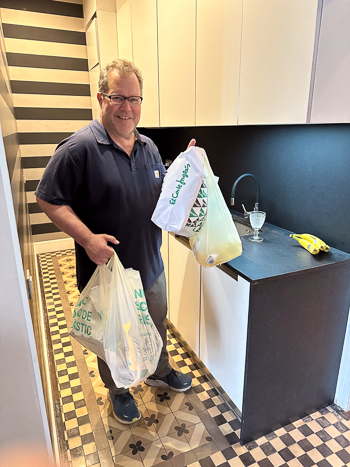

The clerk spoke in Spanish to me then at one point turned to Jim with a meandering question. He had no idea what she said and frankly at that moment, I didn’t either.
She had to keep returning to assist us, eventually with our payment. The screen offered two credit card-looking icons and we had no clue of the difference.
Finally, the machine demanded my PIN number for my Visa card, which I don’t have—just the chip. Our helper typed in some stuff and scanned her magic lanyard and all marvelously corrected. The staff must have felt relieved to see Jim and me go, the two of us like toddlers let loose in the Catalan supermarket.
A couple days later, we ventured back to re-stock on breakfast and snack foods. I knew to bring along our previously purchased bags. We also remembered how to locate our beverages downstairs using the elevator and to hunt down a live checker instead of attempting the do-it-yourself again. We felt pretty smug at this point, though it required the both of us to accomplish anything as remotely herculean as grocery shopping in Europe.
We encountered the same clerk as last time, now manning an actual conveyer belt. She smiled and seemed genuinely pleased to greet us instead of scowling with a “Not you two again!”
She asked if we wanted to acquire a frequent shopper card, perhaps assuming we’d recently moved to the neighborhood. Oh, what horror that would surely be for these young checkers if that were the case.
She had one final advanced question for us: Did we want to bump up our bill 18 cents to help something-or-other kid charity.
Oh, yes, we said!
We may run hapless in the grocery stores of Barcelona, but we’re 18 cents worth of generous.
Modernisme and Gaudi
The Sagrada Familia
This basilica, designed by Catalan architect Antoni Gaudí, swarms with people all day, demonstrating their need for such a careful and strict ticket policy. Our knees weakened over the stained glass inside the church with its red and green and blue swatches reflecting off the walls and flooding the interior. Most people know the church for Gaudí,’s creative exteriors, but we ended up swooning more for its colorful interior, the most beautiful I’ve ever seen.
And it ’s not even finished yet. Jim announced he wants to return after its final completion in 2026.
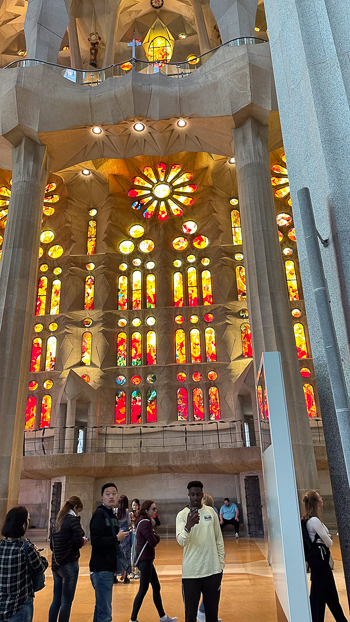
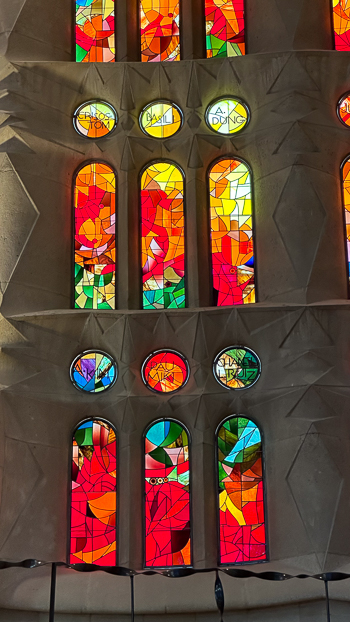
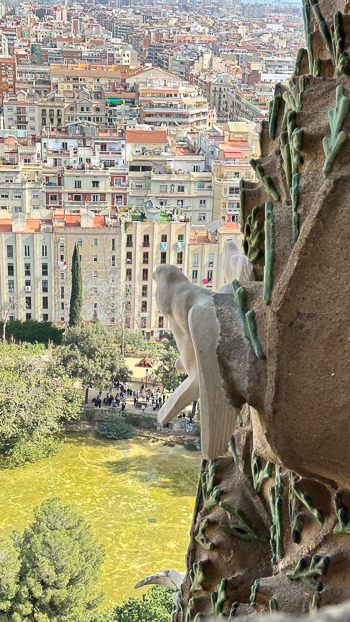
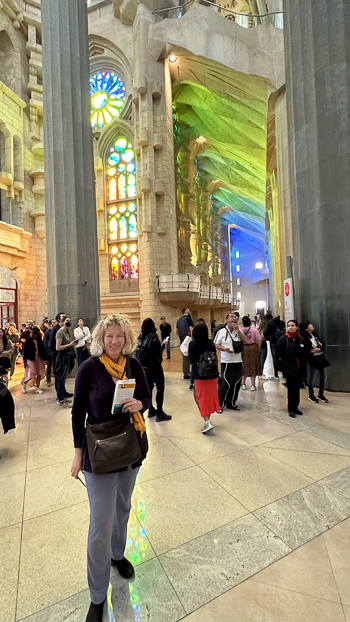
Park Güell
Gaudi’s rambling park has changed a lot since Annie and I went years ago. Back then everyone entered through the main gate and at no cost. Now only locals get to visit for free while the rest of us have to purchase tickets ahead of time before getting routed through the grounds in a confusing one-way grid. You can access the iconic section with the ceramic lizard fountain only once. When you exit the park, you must show your ticket again to get scanned out.
Still, we admired the bright tiles and appreciated all the creativity and labor involved in developing the park. The tiles look like mosaic but aren’t. Gaudi mastered a craft calledtrencadís, assembling his designs with bumpy and broken ceramics, tile, and china doll parts from local factories.
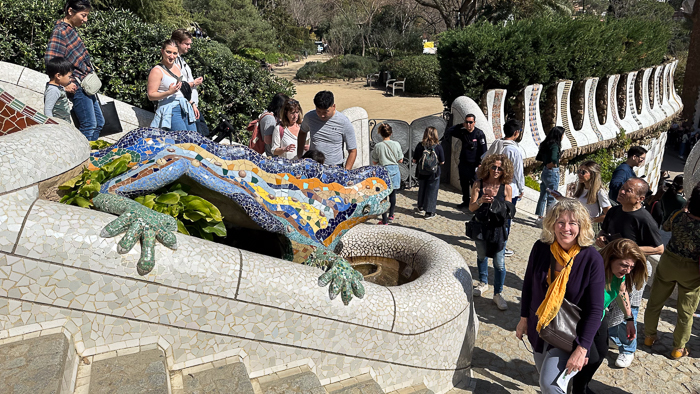

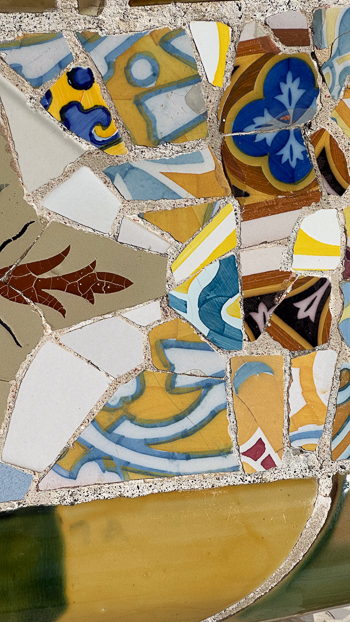
The Palace of Catalan Music
This delightful concert hall, also designed by Gaudi, surprised Jim by how much he liked it. Many American tourists have neither the time nor interest to check it out. During our tour, we got to hear the end of an interactive and enthusiastic a capella concert for appreciative grade school kids.
Everywhere we looked we found Catalan’s “modernisme” style with color, mosaic, glass, and metalwork providing clever decoration inside and out. Modernisme avoids straight lines, instead placing waves wherever possible—just like nature, our guide explained. Even the massive chandeliers hung decidedly off-kilter.
Light poured through stained glass while trencadís ceramics blanketed pillars and walls, every surface an opportunity for decoration. The combined effect of music, schoolchildren, color and design created a scene of jubilation.
Jim and I are taken with the Guadi designs and his embrace of art and functionality together. We realized we’ve decorated our home in Salem with this Spanish modernisme style and didn’t even know it. I suggested to Jim that he include this revelation in his Willamette University lecture.
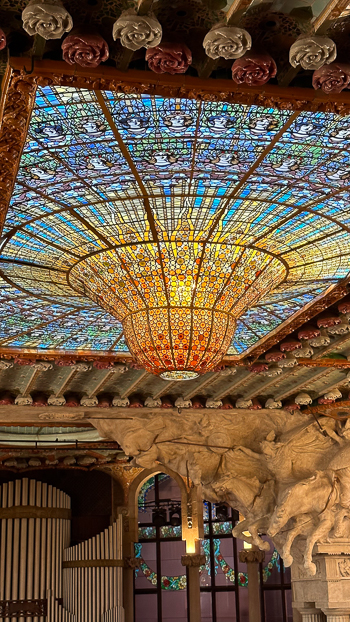

The Block of Discord
This morning we visited three modernisme houses, two of them by Gaudí, on the Block of Discord. Wikipedia describes Modernisme as such:
“Nowadays, it is considered a movement based on the cultural revindication of a Catalan identity.”
More simply put, art as a political force.
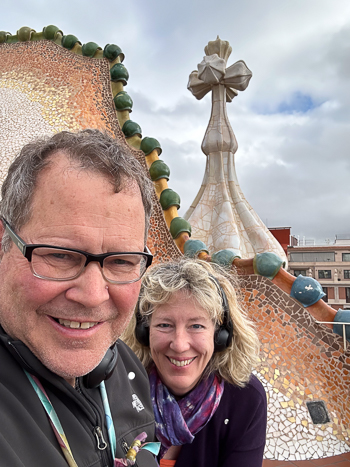
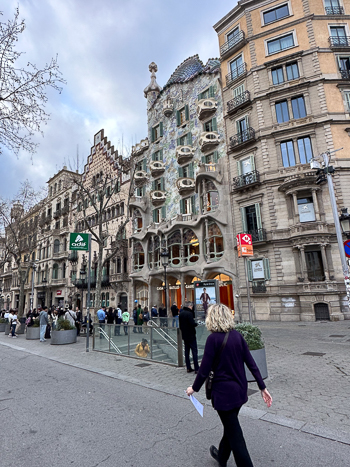
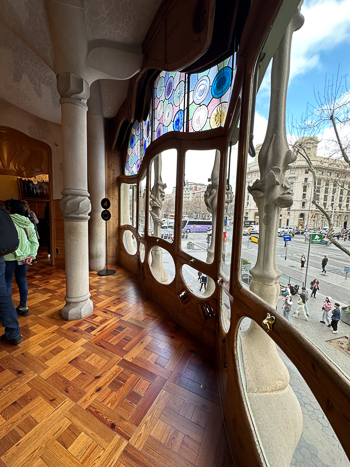
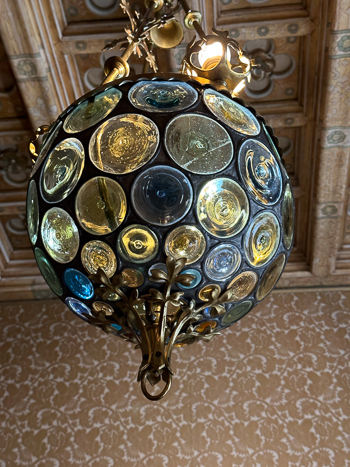
The Spanish Civil War
Today we took a Spanish Civil War walking tour with thirty-something Catherine as our guide. It lasted 3.5 hours but felt much shorter due to her engaging manner, plus we had plenty of opportunities to sit, once while sipping perfect cafe con leches.
Catherine, an academic and historian, has a talent for teaching and managed to break down the confusion of the war. Simply the alphabet soup of Spanish acronyms for left wing blocs could baffle and disorient a listener. But she made the complex understandable—never an easy task.
We’d joined Catherine’s first tour since January. She said that tourism had yet to pick up to pre-pandemic levels and their walking group numbers still lagged.
I told Catherine how we’d booked with them for March of 2020 but of course had to cancel. I asked her about her own experiences during the pandemic, curious to hear how individuals fared in Spain where I’d heard it had been particularly difficult.
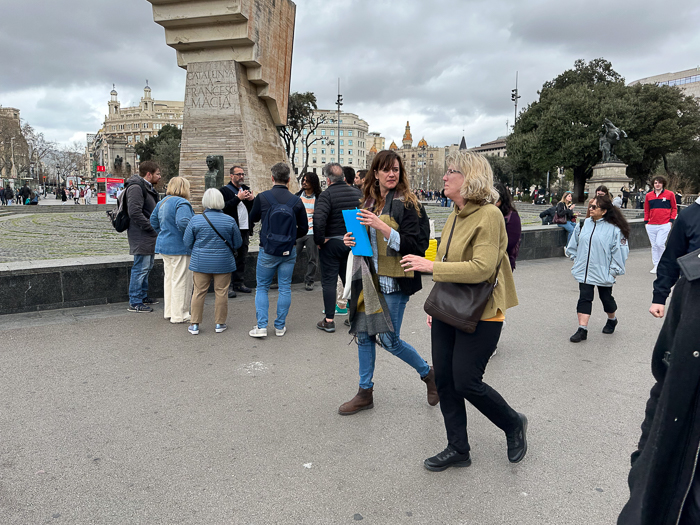
Catherine said she’d actually been studying in Mexico when the virus broke out. Her Mexican airline shut down but she nabbed a seat on the last flight for Barcelona with Air France.
She’d given up her apartment in Barcelona since she’d planned on staying in Mexico for a while. But a friend offered her use of her Bed & Breakfast during lockdown, tight quarters she had to share with a roommate.
Catherine described Barcelona’s strict two-month lockdown. Residents could leave their apartments only for essential outings like to the grocery store or pharmacy, never for a stretch in the fresh air. During a trip to the market, police might require proof you were shopping for necessary items. You’d receive a fine if caught out just buying a candy bar, she said.
Eventually Catherine left Barcelona and returned to her native Ireland which held even stricter pandemic rules. There she waited out the worst, though relieved she’d gotten to “run home to Mom and Dad,” as she put it.
The Sardana
On Barcelona weekends, eleven-piece orchestras gather to play traditional Catalan music in the Gothic quarter, the old cathedral looming overhead. Residents and visitors join in circles for the local folk dance called the sardana. Because of the its association with Catalan nationalism, Franco banned the sardana for a time.
Dancers select their circle based loosely according to their age or athletic ability; there’s a sardana faction for everyone. The senior group included an elderly woman standing with her walker, shifting her feet to the beat while a friend spotted her from behind.
I studied the step patterns for a few minutes before joining the senior citizens, my slower, low-impact comrades.
A woman clasped my hand to my left and a man to my right. I struggled at first with the simple steps.
“Uno, dos, tres, cambia…” The gentleman beside me counted me out, softly encouraging me on.
I caught on sufficiently to avoid embarrassment, dancing joyfully in defiance of a fascist dictator who died 48 years ago.

